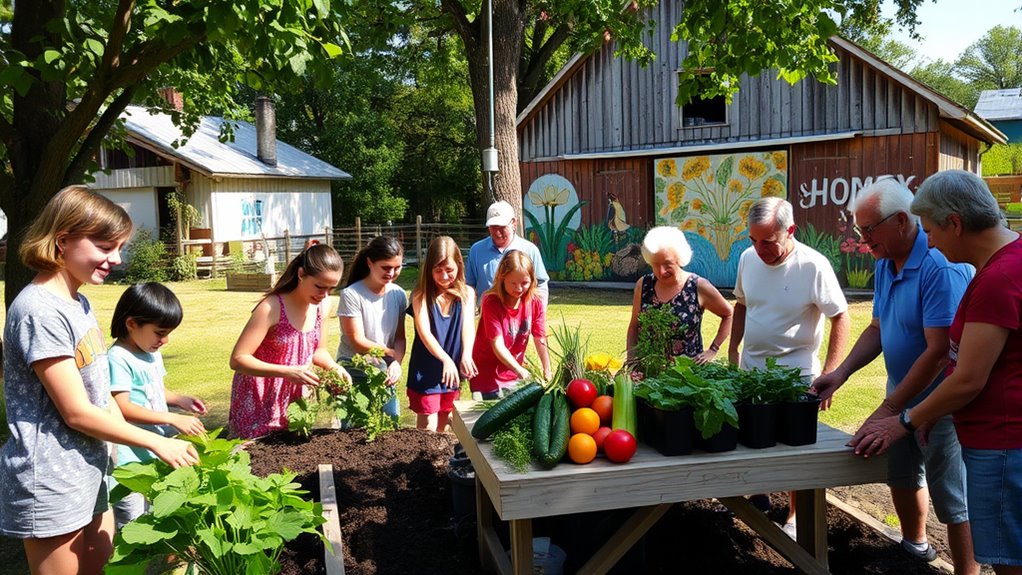Resilience building programs are expanding in rural communities, helping you and your neighbors better withstand disasters. These initiatives empower you to become informed responders and foster self-sufficiency during tough times. By focusing on local needs and promoting emotional well-being, these programs create strong social networks and share valuable resources. You’ll find that engaging in these efforts can enhance community bonds and prepare you for future challenges. Discover more about how these programs can transform rural areas.
Key Takeaways
- Resilience building programs enhance local capacity, empowering rural communities to withstand and recover from disasters effectively.
- Peer networking fosters social capital, enabling community members to share disaster preparedness strategies and collective resources.
- Economic development initiatives in rural areas focus on educational programs that connect individuals to sustainable career opportunities, promoting long-term resilience.
- Sustainable practices and youth innovation within resilience programs encourage regenerative livelihoods and tailored risk reduction strategies for rural communities.
- Community engagement through storytelling and emotional well-being initiatives supports collective resilience and fosters commitment among members during challenging times.

Resilience building programs in rural communities play an indispensable role in enhancing local capacity to withstand and recover from disasters. These initiatives empower you and your neighbors to become informed responders rather than helpless victims. By fostering self-sufficiency, these programs help your community endure extended periods of adversity.
You’ll find that peer networking is fundamental, as it allows you to share strategies with others who face similar challenges, often arising from policies and programs that don’t cater to local needs.
Utilizing social capital is another key aspect of these programs. You can leverage the existing relationships within your community to bolster disaster preparedness and recovery efforts. When everyone pitches in, it creates a stronger safety net. Tailoring disaster recovery processes to fit your community’s unique characteristics guarantees that the support you receive is relevant and effective. After all, one size doesn’t fit all when it comes to recovery.
Moreover, resilience building programs often involve a reassessment of cost-benefit analyses. When you look at the needs of rural communities, these assessments can highlight the significance of adapting resources to fit your specific context. Grant reforms can also alleviate financial burdens, making it easier for you to access the support you need.
It’s about prioritizing community resilience at all levels, and that requires attention from national agencies as well. Economic development initiatives further contribute to building resilience. Programs like Achieving the Dream strengthen rural colleges, equipping students with skills necessary for the digital economy.
This not only narrows equity gaps but also connects you and your peers with family-sustaining career opportunities. When your community thrives economically, it becomes more resilient to future challenges.
Addressing the frequent under-resourcing of rural areas is essential. You can advocate for policy attention and encourage investment in your community. Engaging with international resilience programs, like the Rural Resilience Programme, can also provide valuable insights.
These programs focus on sustainable practices and encourage youth innovation, promoting a shift toward regenerative livelihoods. As you participate in these resilience building programs, you’ll see the importance of tailored risk reduction strategies and resource sharing among communities. Additionally, studies show that pet therapy can enhance emotional well-being, which may be beneficial for community members coping with stress during challenging times.
Storytelling can become a powerful tool for community engagement, allowing you to share experiences and foster commitment to collective resilience. Embracing these initiatives makes your community not just survive but thrive in the face of adversity.
Frequently Asked Questions
How Can I Get Involved in a Resilience Building Program?
You can get involved in a resilience building program by first researching local initiatives in your community.
Attend meetings and join planning committees to share your ideas and connect with others.
Participate in workshops and training sessions to learn new skills.
Volunteer with organizations focused on community engagement, and collaborate with local emergency planning teams.
Are There Specific Age Groups Targeted by These Programs?
Yes, resilience-building programs often target specific age groups.
For older adults, the focus is on enhancing disaster preparedness and coping abilities.
For youth, the programs emphasize school connectedness, community support, and mentorship opportunities.
By engaging different age groups, these programs aim to foster resilience tailored to their unique needs.
If you’re interested, look for local initiatives that cater to your age group and consider participating or volunteering to make a difference.
What Types of Funding Support Are Available for These Initiatives?
You’ll find various funding supports for resilience initiatives, including FEMA’s BRIC grants, which help states and local governments reduce hazard risks.
These often require a 25% non-federal match. Additionally, California’s Community Resilience Centers receive grants aimed at low-income and disadvantaged communities.
Internationally, programs like IFAD’s Rural Resilience Programme provide grants focusing on sustainable agriculture.
Educational initiatives also receive funding to equip students with the skills needed for today’s workforce.
How Are Success Metrics for These Programs Evaluated?
Oh sure, evaluating success metrics for resilience programs is like trying to find a needle in a haystack—if the haystack were made of paperwork!
You’ll immerse yourself in social capital, analyze community feedback, and track your shiny Rural Resilience Index.
You’ll also compare cost-benefit analyses, ensuring no one’s left behind.
Just remember, it’s all about engaging the community, because who doesn’t love a good participatory action research session?
It’s a real party!
Can These Programs Be Adapted for Urban Settings?
Yes, you can adapt resilience-building programs for urban settings.
Start by evaluating unique urban challenges, like population density and infrastructure differences. Tailor strategies to meet the specific social and economic needs of urban communities.
Encourage partnerships among local governments, businesses, and residents to foster collaboration. Integrate innovative solutions and flexible approaches to guarantee scalability.
Conclusion
To sum up, resilience building programs are like seeds planted in the rich soil of rural communities. As they take root, they foster strength and adaptability, helping individuals and families weather any storm that comes their way. By investing in these initiatives, you’re not just nurturing growth; you’re cultivating a thriving ecosystem where hope and opportunity flourish. Embrace the journey, and watch as your community blossoms into a beacon of resilience and support for all.










